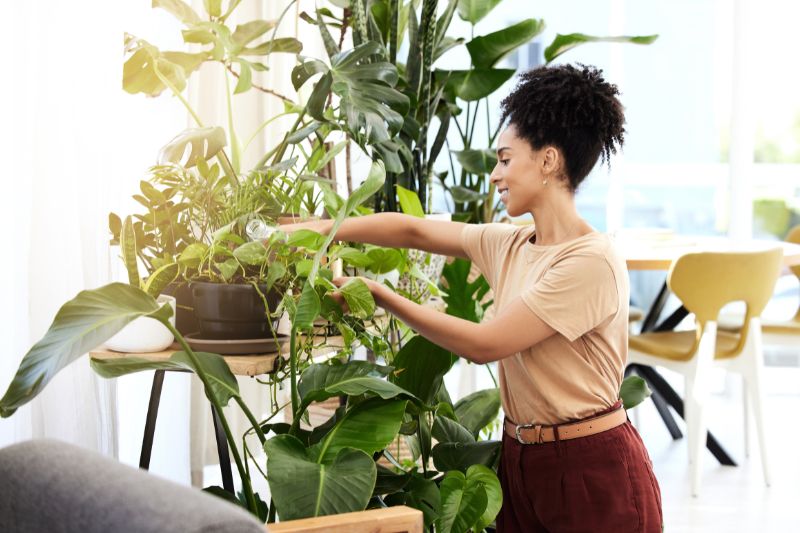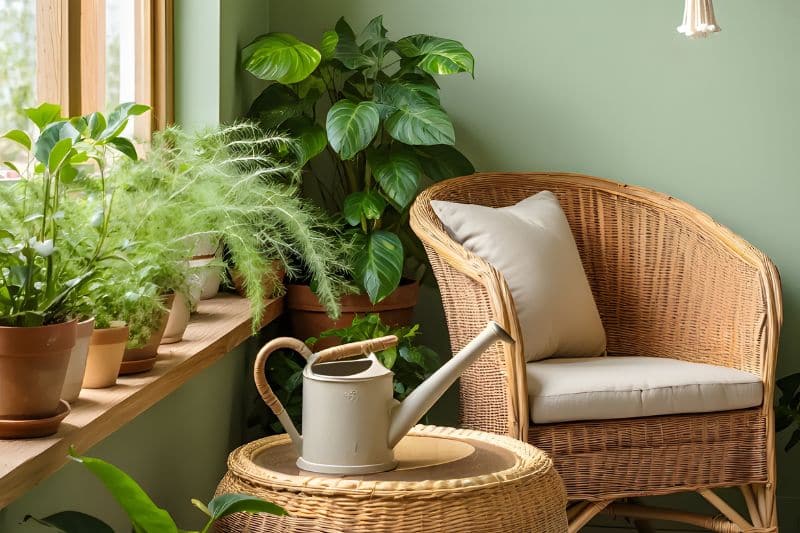Have you ever felt that your houseplants improve your well-being and mood? What if we told you that scientific data has shown that indoor plants have effects on stress, mood, attention, and perception of the quality of spaces? This should inspire you to green up your home and office!

The recognised psychological impact of green plants
The impact of green plants on morale and concentration is now widely recognised. According to several scientific studies, simply caring for or observing indoor plants reduces stress and improves mood. Indeed, the colour green, a symbol of regeneration and balance in chromotherapy (colour therapy), acts as a calming signal for the brain.
But their effect is not limited to colour: repotting a plant, gently watering its soil, or brushing against a velvety leaf activates tactile and olfactory sensations that soothe the nervous system. These simple actions allow for the release of accumulated tension, for example, after a day at work.
By cultivating and caring for these plants, one also develops a sense of responsibility and satisfaction that contributes to emotional balance.

Plants in the office: a source of concentration
A bare office can feel cold or impersonal; adding some foliage changes the perception and truly transforms the atmosphere. A study conducted in the UK and the Netherlands showed that an office adorned with greenery could boost an employee's productivity by about 15%. The observed employees felt more focused, found the air more pleasant, and unconsciously perceived, through these plants, a sign of consideration and care that enhanced their motivation and job satisfaction.

An aesthetic asset to personalise your rooms
From an aesthetic perspective, indoor green plants bring a living and evolving decorative dimension. Unlike inanimate objects, they change with the seasons, grow, sometimes flower, and introduce a natural dynamic that continually refreshes the space.
Their foliage, whether graphic, variegated, or trailing, plays with light and shadows, adding relief and depth to an interior. They thus transform a too-static decoration into a welcoming and warm space. They structure volumes and enliven neglected corners. For example, a Monstera with spectacular foliage draws the eye, while a Ficus or a Pilea adds a graphic touch.
These plants break the overly rigid lines of furniture and rooms in our interiors, bringing volume and texture contrast that enriches the decoration, thus contributing to a sense of well-being at home.

Oxygen-producing plants: a real but often overestimated effect
We know that green plants produce oxygen through photosynthesis and absorb carbon dioxide. Moreover, research, such as that conducted by NASA, has shown that some green plants even absorb certain pollutants, notably the peace lily (Spathiphyllum) or Chlorophytum (Spider Plant). However, the amounts of oxygen produced in the scale of a living room or office are actually low compared to the volume of air. A very large number of plants would be needed to achieve a complete renewal of the oxygen in a room.
But that doesn't mean their presence is useless! Indoor plants improve psychological comfort, slightly increase ambient humidity, and promote a more pleasant atmosphere, which indirectly contributes to a sense of freshness and well-being.
Choosing your indoor green plants wisely
For a lasting and harmonious effect, select plants suited to the light levels of each room and the time you can realistically dedicate to them. Here are some examples:
- In a bright room, a Ficus or an Areca palm (Areca) will thrive and give a tropical look.
- For less bright corners, a Zamioculcas or a Sansevieria remains decorative without too much maintenance.
- Ferns and Calathea appreciate a more humid atmosphere. They are perfect for a well-lit bathroom.
- If you are often away or very busy, an Aloe vera or a Pothos (Epipremnum) will be perfect, as they are low-maintenance in terms of watering and care. In contrast, a Calathea, a Boston fern, or an Orchid requires regular attention.
Tip: Also consider the style of your interior and the size of the plants to create a balanced ensemble.

Creating a refreshing ambience with plants
The arrangement of plants also plays a role in their aesthetic and soothing effect. Varying heights, combining pots made of wood, terracotta, or metal (or according to your interior decor), and associating foliage with different shapes adds relief. Placing a large specimen near a window, a small pot on a shelf, or a hanging plant from the ceiling creates an impression of naturalness and movement. Caring for these plants becomes a relaxing routine that helps slow down and savour your environment.
Integrating indoor plants is therefore an effective way to enhance creativity, concentration, and quality of life on a daily basis.































Comments